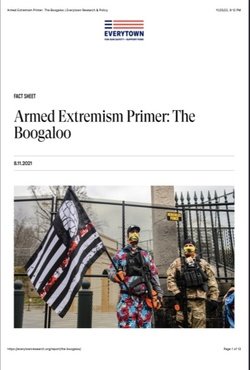By Everytown for Gun Safety
The boogaloo movement has risen to national prominence as a new and dangerous subset of the extreme right in the United States. Boogalooers focus on and fantasize about a supposedly imminent second civil war, referred to as the “boogaloo,” wherein the corruption they see in the political system will be overthrown. This is still an emergent movement, but its ideological core centers around guns and distrust of authority, whether that be the government, police, or political institutions. The movement originated on the internet forum 4chan, and adherents to the boogaloo movement continue to be active online in various forums and social media platforms. Many media portrayals have focused on the seemingly quixotic traits of boogalooers, like their habit of wearing Hawaiian shirts, communicating via internet memes, or their name being derived from the 1984 break-dancing movie Breakin’ 2: Electric Boogaloo. But make no mistake, the boogaloo movement is inherently violent, well armed, and organized around preparations for a civil war purportedly coming to America’s streets. Individuals tied to the boogaloo movement have already plotted attacks and committed violence, and intelligence and law enforcement agencies have pointed to a growing threat emanating from the movement. As previous research from Everytown has demonstrated, an entire extreme-right ecosystem serves as a breeding ground for individuals aliated with far-right movements such as the boogaloo, providing both inspiration and motivation—whether political, conspiratorial, or racist—for them to act.
New York: Everytown for Gun Safety, 2021. 10p.




